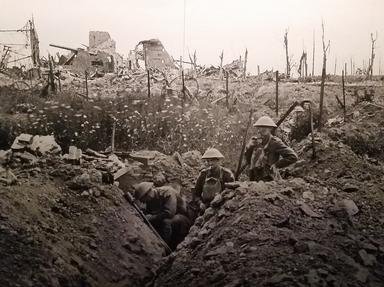Quiz Answer Key and Fun Facts
1. In which region of France is the Somme battlefield located?
2. The main section of the Somme battlefield is bisected by a straight road originally built by the Romans. Which two towns does it connect?
3. The Somme offensive was specifically planned partly with the intention of drawing German troops away from which other battle front?
4. The first day of the 1916 Somme offensive was the bloodiest day in the history of the British and Commonwealth armed forces. What was the date?
5. The 1st Battalion of which British dominion's regiment suffered a 75% casualty rate within half an hour of its assault on German positions at Beaumont-Hamel on the opening day of the Somme offensive?
6. For what conspicuous act of gallantry was Private William McFadzean of the 14th Btn, Royal Irish Rifles, awarded the first of the 51 Victoria Crosses won during the Battle of the Somme?
7. American poet Alan Seeger, uncle of folk-singer Pete Seeger, was killed on the first day of the 1916 Somme offensive whilst attacking the village of Belloy-en-Santerre. With which unit was he serving?
8. A shallow depression south of the village of La Boisselle in the centre of the Somme battlefield was nicknamed 'Sausage Valley' because of a German observation balloon stationed there. By what name was a similar shallow valley north of the same village known?
9. One of the most visible reminders of the fighting on the Somme is a crater formed by a vast mine exploded beneath the German lines to the south-east of La Boisselle immediately prior to the initial assault. What is the crater called?
10. Which area of Germany gave its name to the daunting stronghold on Thiepval Ridge, an insurmountable objective of the 36th (Ulster) Division on the first day of the Somme campaign?
11. A striking memorial to the fighting men of which country stands under the southern edge of Mametz Wood, where over 4,000 of its sons were killed or wounded between 7th and 12th July 1916?
12. Which category best describes the majority of British and Empire troops who fought on the Somme in 1916?
13. Known as 'Mad Jack' to his men for his apparently suicidal exploits, which writer and poet who served on the Somme as a Second Lieutenant in the Royal Welch Fusiliers had previously won the Military Cross for raiding the German trench lines at Fricourt?
14. Which village situated at the highest point of the entire Somme battlefield was taken by the Australian 1st Division on July 23rd, 1916, the nearby ridge described by the official historian as being "more densely sown with Australian sacrifice than any other place on earth."?
15. Cpt. Noel Chavasse of the Royal Army Medical Corps won a Victoria Cross at Guillemont on August 15, 1916, for seeking out, and attending to, wounded men whilst under heavy fire. What was his remarkable subsequent achievement?
16. Which infamous wood adjacent to the village of Longueval in the south-east central part of the Somme battlefield is today home to a South African National Memorial and Museum?
17. Which future British Prime Minister was seriously wounded in a dawn attack at Lesboeufs on 15th September 1916 and then spent eight or nine hours in a muddy shell-hole reading "Prometheus Bound" in the original Greek?
18. What weapon was used for the first time in combat history at Flers in the eastern part of the Somme battlefield on September 15th, 1916?
19. Who was seriously wounded on the Somme battlefield on October 7th, 1916, when a British artillery shell penetrated his dugout, killing several of his nearby comrades?
20. In November 1916, the Germans began work on a new line of fortifications some distance behind the Somme battlefront in order to shorten their lines of defence. After which newly-appointed Supreme Commander of the Army was this formidable obstacle unofficially named?
21. Who was in overall command of the French armies which fought in the southern sectors of the Somme battlefield between July and November 1916?
22. Between July and November 1916, it is estimated that the German forces suffered how many casualties (dead, wounded or taken prisoner) during the Somme campaign?
23. Completed in 1932, the largest British war memorial in the world stands on which part of the Somme battlefield?
24. In 1992, it was revealed that a famous fictional character was taken prisoner by the Germans whilst serving in a Belgian unit on the Somme in August 1916. Who was this character?
25. Seen on headstones across the Western Front and particularly in evidence on the Somme, which three-word formulation devised by Rudyard Kipling is used on all British and Commonwealth graves to indicate the unidentified fallen?
Source: Author
Richie15
This quiz was reviewed by FunTrivia editor
bloomsby before going online.
Any errors found in FunTrivia content are routinely corrected through our feedback system.

